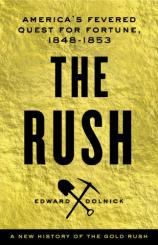The Rush: America's Fevered Quest for Fortune, 1848-1853
Review
The Rush: America's Fevered Quest for Fortune, 1848-1853
It happened on January 24, 1848, when “a moody oddball carpenter…muttered a phrase destined to become famous. ‘Boys, by God, I believe I have found a gold mine!’”
For five years afterwards, Americans --- along with a fair share of foreigners --- were beset by "gold fever." Young men from the East, who had never hefted anything heavier than a pen, headed for the gold fields of north-central California for the opportunity, they reckoned, of becoming overnight millionaires by picking gleaming nuggets off the ground. The reality differed starkly from the dream. Living in camps with broken furniture, sleeping in their clothes, and ceaselessly shoveling tons of rock while standing up to their knees in mud, the prospectors existed on the slim hope of discovering a rich vein or a bag of flakes that would set them up for life.
"Science writer Edward Dolnick...has mined contemporary diaries for this glittering mother lode of eyewitness accounts, fascinating tales of real people who left home with high hopes and doggedly stayed on despite the daily adversities."
Science writer Edward Dolnick (THE CLOCKWORK UNIVERSE, THE FORGER’S SPELL) has mined contemporary diaries for this glittering mother lode of eyewitness accounts, fascinating tales of real people who left home with high hopes and doggedly stayed on despite the daily adversities. The journey itself was enough to discourage even the most determined. Consider this hair-raising observation from a couple traveling overland: “Sometimes we found the bones of men bleaching beside their broken down and abandoned wagons.” Greenhorns quickly became grizzled and gaunt --- men who, with a few chunks of precious metal in their pockets, could party on their earnings not just for a night but for weeks at a stretch. Few, it seemed, had the knack for holding on to what they found.
Those who came to do the miners’ laundry and sell them their drinks seemed, overall, to have been the big winners in the search for fortune. Young women left “the states” gladly, to work in boarding houses for wages far greater than any back home. Though the work was just as hard, the ambience was undeniably exhilarating --- constant brawling, carousing and the chance that someone’s fortune might be made at any minute. A resourceful woman could set up a profitable cookhouse in the camps with just a few boards and benches. John Horner, a New Jersey native, tried his hand at prospecting, then went back to farming near the gold fields. In 1849, Horner made the equivalent of $160,000 in today’s currency selling vegetables to the miners who, sometimes afflicted with scurvy, would pay any price for a potato or an onion, and wolf it down raw in their desperation for fresh food.
Dolnick lays out both the external and internal landscape of this remarkable period in American history. Gold fever turned San Francisco into a modern city and California into a state. The emotive images of the grizzled prospector, ambitious prostitute, savvy merchant, and few miners who actually struck it rich and managed to hold on to their hard-won gains, all are part of our folklore.
Reviewed by Barbara Bamberger Scott on August 15, 2014
The Rush: America's Fevered Quest for Fortune, 1848-1853
- Publication Date: August 12, 2014
- Genres: History, Nonfiction
- Hardcover: 368 pages
- Publisher: Little, Brown and Company
- ISBN-10: 0316175684
- ISBN-13: 9780316175685










